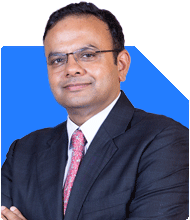Samraat Jadhav |2392 Answers |Ask -Follow
Stock Market Expert - Answered on May 07, 2024
He is a SEBI-registered investment and research analyst and has over 18 years of experience in managing high-end portfolios.
A management graduate from XLRI-Jamshedpur, Jadhav specialises in portfolio management, investment banking, financial planning, derivatives, equities and capital markets.... more

Sir, I am Patil 64 yr old retired professor started SIP from 2023 as 10000 in SBI Contra growth, 5000 in SBI devidend yield and 5000 in Nippon innovation. May I continue with, kindly advice. If any suggestions I can add few more. Hopping for expert advice. Thanking you sir.
You may like to see similar questions and answers below
Omkeshwar Singh | Answer |Ask -Follow
Head, Rank MF - Answered on Nov 04, 2022
Abhishek Dev | Answer |Ask -Follow
Financial Planner - Answered on Sep 13, 2023
Ramalingam Kalirajan |9854 Answers |Ask -Follow
Mutual Funds, Financial Planning Expert - Answered on May 07, 2024
Ramalingam Kalirajan |9854 Answers |Ask -Follow
Mutual Funds, Financial Planning Expert - Answered on May 14, 2024
Ramalingam Kalirajan |9854 Answers |Ask -Follow
Mutual Funds, Financial Planning Expert - Answered on Nov 19, 2024
Nayagam P P |9445 Answers |Ask -Follow
Career Counsellor - Answered on Jul 26, 2025
Nayagam P P |9445 Answers |Ask -Follow
Career Counsellor - Answered on Jul 26, 2025
Nayagam P P |9445 Answers |Ask -Follow
Career Counsellor - Answered on Jul 26, 2025
Ramalingam Kalirajan |9854 Answers |Ask -Follow
Mutual Funds, Financial Planning Expert - Answered on Jul 26, 2025
Dr Upneet Kaur |63 Answers |Ask -Follow
Marriage counsellor - Answered on Jul 26, 2025
Dr Upneet Kaur |63 Answers |Ask -Follow
Marriage counsellor - Answered on Jul 26, 2025
Nayagam P P |9445 Answers |Ask -Follow
Career Counsellor - Answered on Jul 26, 2025
Dr Upneet Kaur |63 Answers |Ask -Follow
Marriage counsellor - Answered on Jul 26, 2025
Dr Upneet Kaur |63 Answers |Ask -Follow
Marriage counsellor - Answered on Jul 26, 2025
Nayagam P P |9445 Answers |Ask -Follow
Career Counsellor - Answered on Jul 26, 2025






















